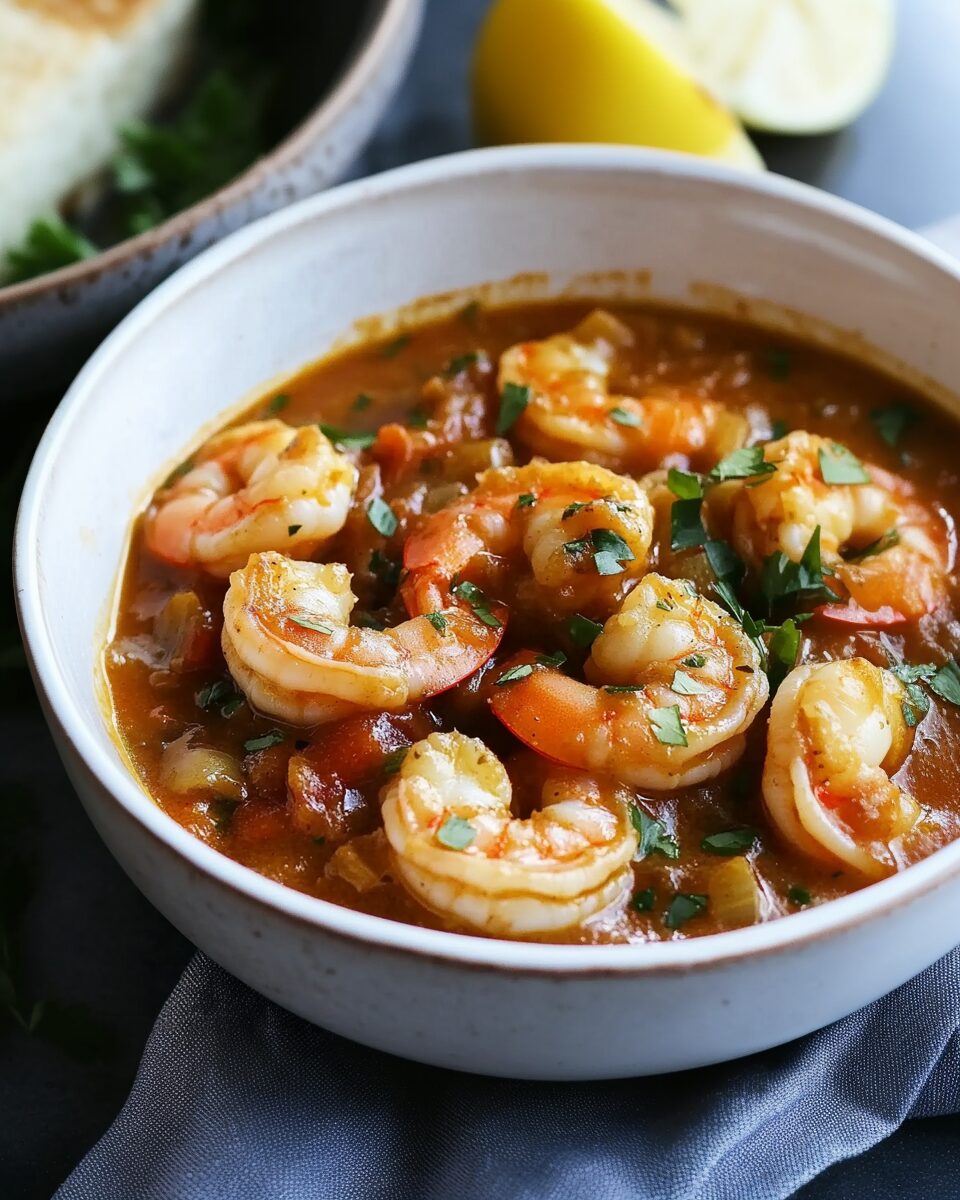Shrimp Étouffée is a classic Louisiana dish that embodies the rich culinary traditions of Cajun and Creole cuisines. The term “étouffée” translates to “smothered,” reflecting the method of cooking shrimp in a flavorful, roux-thickened sauce. This hearty dish is typically served over rice, making it a comforting and satisfying meal.
Full Recipe:
Ingredients
- 2 pounds medium shrimp, peeled and deveined
- 1/2 teaspoon salt
- 1 tablespoon vegetable oil
- 1 3/4 cups chicken stock, or as needed
- 3 tablespoons butter
- 1/3 cup diced onion
- 1/3 cup diced green bell pepper
- 1/3 cup thinly sliced celery
- 2 tablespoons all-purpose flour
- 1/2 cup diced tomatoes
- 1/2 teaspoon Worcestershire sauce
- 1 dash hot sauce, or more to taste
- Salt to taste
- 1/4 cup sliced green onions
- Cayenne pepper for garnish
- 2 cups cooked rice, or to taste
Spice Blend:
- 3/4 teaspoon paprika
- 1/4 teaspoon ground thyme
- 1/4 teaspoon dried oregano
- 1/4 teaspoon cayenne pepper
- 1/4 teaspoon garlic powder
- 1/4 teaspoon onion powder
- 1/4 teaspoon white pepper
- 1/4 teaspoon ground black pepper
Directions
-
Prepare the Spice Blend: In a small bowl, whisk together paprika, thyme, oregano, cayenne, garlic powder, onion powder, white pepper, and black pepper.
-
Season the Shrimp: Place the shrimp in a bowl, season with 1 teaspoon of the prepared spice blend and 1/2 teaspoon salt. Toss to coat evenly.
-
Cook the Shrimp: Heat vegetable oil in a large skillet over high heat until shimmering. Add the shrimp and cook without stirring for 1 minute. Stir and cook for an additional minute until shrimp are just pink. Transfer shrimp to a bowl and set aside.
-
Prepare the Roux: In the same skillet, melt butter over medium heat. Add flour and cook, stirring continuously, until the mixture turns a light brown color, about 3-4 minutes.
-
Cook the Vegetables: Add the diced onion, bell pepper, and celery to the roux. Cook, stirring frequently, until the vegetables soften, approximately 5 minutes.
-
Add Tomatoes and Seasonings: Stir in the diced tomatoes and the remaining spice blend. Cook for about 3 minutes, allowing the flavors to meld.
-
Incorporate the Stock: Gradually whisk in the chicken stock, ensuring the mixture is smooth. Bring to a simmer and cook until the sauce thickens to a gravy-like consistency, about 3-5 minutes.
-
Season the Sauce: Add Worcestershire sauce and a dash of hot sauce. Adjust salt to taste.
-
Combine Shrimp and Sauce: Return the cooked shrimp to the skillet, stirring to coat them in the sauce. Cook for an additional 1-2 minutes until the shrimp are heated through.
-
Serve: Ladle the Shrimp Étouffée over cooked rice. Garnish with sliced green onions and a sprinkle of cayenne pepper for added heat.
Nutritional Facts
Per Serving (excluding rice):
- Calories: 250
- Protein: 30g
- Carbohydrates: 10g
- Dietary Fiber: 2g
- Sugars: 3g
- Fat: 10g
- Saturated Fat: 4g
- Cholesterol: 220mg
- Sodium: 600mg
- Potassium: 450mg
Historical Background
The origins of Étouffée are deeply rooted in the cultural tapestry of Louisiana, reflecting a fusion of French, African, Spanish, and Native American culinary traditions. The term “étouffée” is derived from the French word meaning “to smother,” aptly describing the cooking technique where seafood is gently simmered in a rich, flavorful sauce. Historical accounts suggest that the dish first emerged in the early 20th century within the Cajun community of Breaux Bridge, Louisiana, often hailed as the “Crawfish Capital of the World.” Initially prepared with crawfish, the recipe evolved to incorporate shrimp, adapting to regional seafood availability and preferences.
Cultural Significance
In Louisiana, food serves as a conduit for storytelling and community bonding, with Shrimp Étouffée standing as a testament to this tradition. The dish embodies resilience and creativity, symbolizing the ability of diverse communities to craft nourishing and flavorful meals from locally sourced ingredients. It is a staple during festive occasions and family gatherings, reinforcing its role in preserving and celebrating Louisiana’s rich cultural heritage.
Cajun vs. Creole Variations
Shrimp Étouffée straddles the line between Cajun and Creole cuisines, each imparting distinct characteristics to the dish:
-
Cajun Version: Originating from the rural Acadian communities, the Cajun rendition typically features a darker roux made from oil or lard and flour, resulting in a deep, earthy flavor. This version often excludes tomatoes and emphasizes the “holy trinity” of onions, bell peppers, and celery, seasoned assertively with spices to deliver a robust and hearty profile.
-
Creole Version: Emerging from the cosmopolitan influences of New Orleans, the Creole variation incorporates a lighter, butter-based roux and often includes tomatoes, lending a slightly sweeter and more complex flavor. This version reflects the European culinary techniques and diverse cultural influences that characterize Creole cooking.
Key Ingredients and Flavor Profile
The allure of Shrimp Étouffée lies in its symphony of ingredients that coalesce to create a rich and satisfying dish:
-
Roux: Serving as the foundation, the roux—a blend of fat and flour cooked to varying degrees—imparts depth and thickness to the sauce. The choice between a light or dark roux influences the overall flavor and color of the dish.
-
Holy Trinity: Aromatic vegetables comprising onions, bell peppers, and celery form the backbone of the dish, providing a fragrant and flavorful base that is a hallmark of Louisiana cuisine.
-
Shrimp: Fresh, locally sourced shrimp are the centerpiece, offering a tender and succulent texture that absorbs the rich flavors of the sauce.
-
Seasonings: A blend of spices, including paprika, cayenne pepper, thyme, oregano, and garlic powder, infuses the dish with warmth and complexity, allowing for customization of heat levels to suit individual preferences.
Cooking Technique
The preparation of Shrimp Étouffée is a labor of love, requiring patience and attention to detail:
-
Roux Preparation: The process begins with crafting the roux, carefully cooking the fat and flour mixture to the desired hue, which sets the flavor foundation for the dish.
-
Sautéing Aromatics: The holy trinity is sautéed in the roux until softened, releasing their natural sweetness and building layers of flavor.
-
Simmering: The seasoned shrimp are gently simmered in the sauce, allowing them to cook through while absorbing the rich, spicy essence of the gravy.
-
Serving: The finished étouffée is ladled over a mound of fluffy white rice, which serves to soak up the flavorful sauce and provide a comforting base for the dish.
Nutritional Considerations
Shrimp Étouffée offers a balance of protein and carbohydrates, with the shrimp providing a lean source of protein and essential nutrients such as iodine and omega-3 fatty acids. The dish’s calorie content can vary based on the amount of butter and type of roux used. For a lighter version, one might consider using a reduced amount of fat in the roux and serving the étouffée over brown rice to increase fiber content.
Serving Suggestions
To elevate the dining experience, consider pairing Shrimp Étouffée with complementary side dishes and beverages:
-
Sides: A crisp green salad dressed with a light vinaigrette or steamed seasonal vegetables can provide a refreshing contrast to the richness of the étouffée.
-
Bread: A slice of crusty French bread is ideal for sopping up the flavorful sauce, ensuring that none of the delicious gravy goes to waste.
-
Beverages: A chilled glass of white wine, such as Sauvignon Blanc or Chardonnay, pairs well with the dish, offering a crisp acidity that complements the creamy, spicy flavors.
Conclusion
Shrimp Étouffée stands as a culinary emblem of Louisiana’s diverse heritage, encapsulating the state’s history, cultural amalgamation, and gastronomic ingenuity. Its rich tapestry of flavors and textures invites both cooks and diners to partake in a tradition that transcends mere sustenance, offering a taste of the stories and communities that have shaped this beloved dish.






